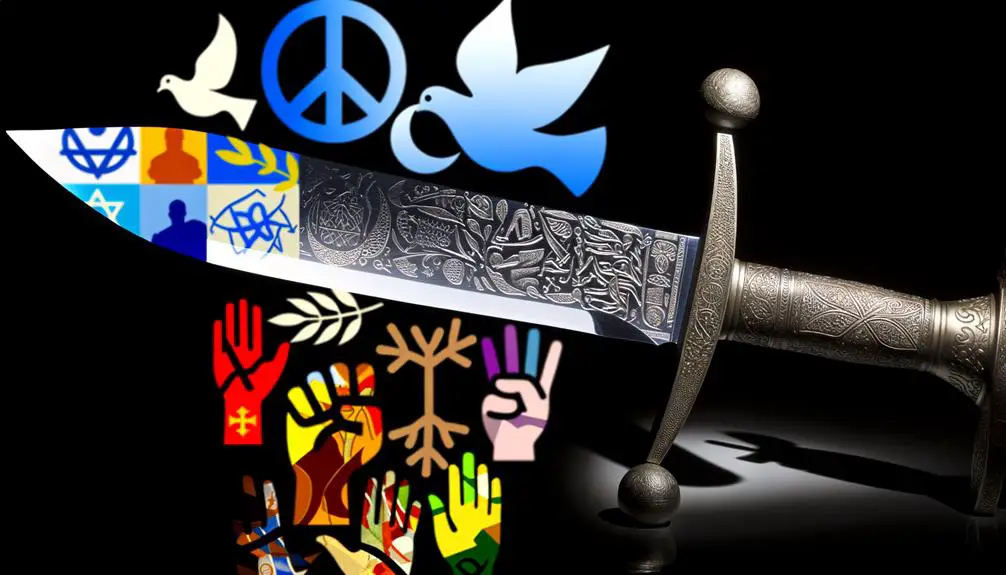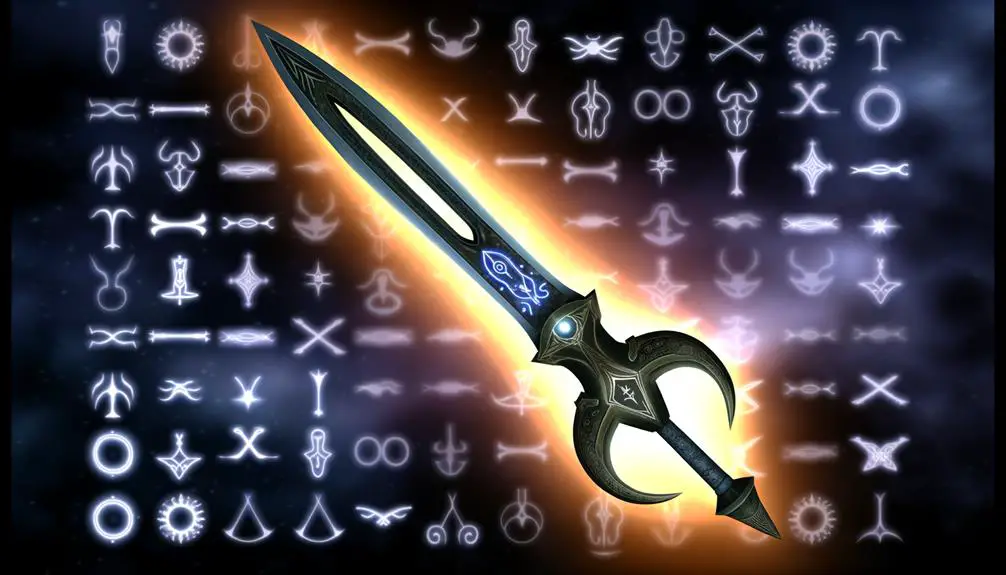What Is the Meaning of a Double-Edged Sword as a Symbol?
The double-edged sword symbolizes duality, as both beneficial and harmful. Its origins trace back to ancient civilizations like Mesopotamia, Egypt, and Greece.
Various cultures have attributed meanings such as divine justice (Islam), creation and destruction (China), and soul's extension (Japan). Mythologies often depict it to illustrate balance and power; for instance, in Greek tales, it highlights the perils of ambition.
In literature, it underscores moral ambiguity and internal conflict, as seen in Shakespeare's 'Macbeth'. Modern representations in media further showcase human complexity and difficult decisions, indicating that this symbol's intrigue spans millennia.
To uncover more about its far-reaching implications…

Key Takeaways
- Represents duality, embodying both protection and potential harm.
- Symbolizes moral ambiguity and complex decision-making.
- Reflects balance and the paradoxical nature of power and responsibility.
- Highlights the risks and rewards associated with significant choices.
- Used to illustrate internal struggles and conflicting outcomes in narratives.
Historical Origins

The concept of the double-edged sword can be traced back to ancient civilizations, where it served as both a literal weapon and a metaphorical symbol in literature and culture.
Historical records indicate that double-edged swords were prominent in Mesopotamian, Egyptian, and Greek societies. These weapons were not only practical for battle but also carried profound symbolic weight.
Archaeological findings, such as the bronze swords from the Shang Dynasty and the iron swords from the Roman Empire, underscore their widespread use.
In ancient texts, double-edged swords often represented duality, embodying notions of both protection and potential harm. This duality was frequently highlighted in epics and mythologies, providing a nuanced interpretation of the consequences inherent in wielding such a powerful instrument.
Cultural Interpretations

Numerous cultures have imbued the double-edged sword with rich, multifaceted symbolism, reflecting their unique philosophical, spiritual, and moral frameworks.
In ancient China, it symbolized the duality of life, embodying both creation and destruction, harmonizing with Taoist principles.
In Islamic culture, it represented divine justice, signifying the balance between mercy and severity.
Japanese samurai revered the katana, a double-edged blade, as an extension of the soul, emphasizing honor and discipline.
Western traditions often linked the double-edged sword to the concept of moral ambivalence, illustrating the potential for both good and evil actions.
These cultural interpretations demonstrate the universality and complexity of the double-edged sword as a symbol, shaped by diverse historical contexts and philosophical ideologies.
Mythological References

In mythological narratives, the double-edged sword frequently appears as a potent emblem of duality and balance, often wielded by gods, heroes, and mythical beings to symbolize the intertwined nature of creation and destruction.
This symbol's recurrence across diverse mythologies underscores its profound significance:
- Greek Mythology: The sword of Damocles, exemplifying the perils of power.
- Norse Mythology: Odin's Gungnir, symbolizing both war and wisdom.
- Hindu Mythology: Kali's sword, representing both protection and annihilation.
- Arthurian Legend: Excalibur, embodying rightful sovereignty and responsibility.
- Japanese Mythology: The Kusanagi sword, a symbol of divine authority and heroism.
These mythological allusions illustrate how the double-edged sword serves as a metaphorical anchor, elucidating the perpetual balance of opposing forces.
Literary Significance

Exploring the literary significance of the double-edged sword reveals its multifaceted role as a symbol of duality and conflict in narratives across various genres. This symbol often reflects the paradoxical nature of characters or situations, embodying both protection and harm, creation and destruction. In literature, it is frequently utilized to underscore moral ambiguity or internal struggle. For instance, Shakespeare's use of the sword in "Macbeth" signifies ambition that leads to both rise and ruin.
| Literary Work | Symbolic Meaning of Double-Edged Sword |
|---|---|
| "Macbeth" | Ambition and Destruction |
| "The Odyssey" | Heroism and Hubris |
| "Beowulf" | Strength and Vulnerability |
| "The Iliad" | Glory and Tragedy |
| "The Scarlet Letter" | Sin and Redemption |
This duality enriches the narrative, making the double-edged sword a potent literary device.
Modern Representations

Building on its rich literary heritage, the double-edged sword continues to serve as a powerful symbol in modern media, encapsulating the complexities of moral dilemmas and the duality of human nature in contemporary narratives. This symbol is employed across various platforms to illustrate nuanced themes:
- Film: Characters often face choices with both beneficial and detrimental outcomes.
- Literature: Protagonists grapple with actions that have unintended consequences.
- Television: Storylines explore the ethical ambiguities of heroism and villainy.
- Video Games: Players encounter decisions that impact the game world in unforeseen ways.
- Graphic Novels: Visual storytelling highlights the peril and potential of wielding power.
In each medium, the double-edged sword remains a potent metaphor, underscoring the inherent risks and rewards of complex decisions.
Conclusion
The symbol of the double-edged sword carries diverse meanings, deeply rooted in historical origins, cultural interpretations, mythological references, and literary significance.
Modern representations continue to reflect its dual nature, embodying both beneficial and detrimental potentials.
In-depth research and contextual analysis reveal the symbol's pervasive influence across various domains.
This extensive examination underscores the enduring complexity and relevance of the double-edged sword as a visual representation of duality and the inherent balance of opposing forces.





